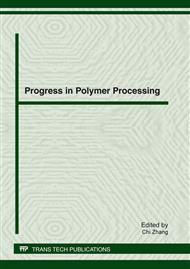[1]
YU HuanYan, Murari PRASAD, HE XiuLan, SHAN LianWei, QI ShuYan, 2009. Discoloration of Rhodamine B dyeing wastewater by schorl-catalyzed Fenton-like reaction. Sci. in China Series E: Technol. Sci. 52(10),3054-3060
DOI: 10.1007/s11431-009-0304-0
Google Scholar
[2]
J. Sanz, J. I. Lombrana, A.M. De Luis, M. Ortueta, F. Varona, 2003. Microwave and Fenton's reagent oxidation of wastewater. Environ. Chem. Lett., 1, 45-50
DOI: 10.1007/s10311-002-0007-2
Google Scholar
[3]
Moraes, J.E.F., Quina, F.H., Nascimento, C.A.O., Silva, D.N., Chiavone Filho, O., 2004. Treatment of saline wastewater contaminated with hydrocarbons by the photo-Fenton process. Environ. Sci. Technol. 38, 1183-1187
DOI: 10.1021/es034217f
Google Scholar
[4]
Panagiotis Bouras, Panagiotis Lianos., 2008. Synergy Effect in the Combined Photodegradation of an Azo Dye by Titanium dioxide Photocatalysis and Photo-Fenton Oxidation. Catal. Lett. 123, 220-225
DOI: 10.1007/s10562-008-9466-9
Google Scholar
[5]
Anna Da Pozzo, Paola Ferrantelli, Carlo Merli, Elisabetta Petrucci, 2005. Oxidation efficiency in the electro-Fenton process. J. Appl. Electrochem. 35, 391-398
DOI: 10.1007/s10800-005-0801-1
Google Scholar
[6]
G. R. Agladze, G. S. Tsurtsumia, B.I. Jung, J. S. Kim, G. Gorelishvili., 2007. Comparative study of chemical and electrochemical Fenton treatment of organic pollutants in wastewater. J. Appl. Electrochem. 37, 985-990
DOI: 10.1007/s10800-007-9325-1
Google Scholar
[7]
Jun Liang, Sergey Komarov, Naohito Hayashi, Eiki Kasai, 2007. Recent trends in the decomposition of chlorinated aromatic hydrocarbons by ultrasound irradiation and Fenton's reagent. J. Mater. Cycles. Waste Manag. 9, 47-55
DOI: 10.1007/s10163-006-0158-5
Google Scholar
[8]
Cheng, M., Ma,W., Li, J., Huang, Y., Zhao, J., Wen, Y.X., Xu, Y., 2004. Visible-light-assisted degradation of dye pollutants over Fe(III)-loaded resin in the presence of H2O2 at neutral pH values. Environ. Sci. Technol. 38, 1569-1575.
DOI: 10.1021/es034442x
Google Scholar
[9]
Matta R, Hanna K, Chiron S. 2007, Fention-like oxidation of 2,4,6-trinitrotoluene using different iron minerals. Sci. Total Environ., 385: 242-251.
DOI: 10.1016/j.scitotenv.2007.06.030
Google Scholar
[10]
B. Muthukumari, K. Selvam, I. Muthuvel, M. Swaminathan. 2007. Photoassisted hetero-Fenton mineralization of azo dyes by Fe(II)-Al2O3 catalyst, J. Chem. Eng.,153: 9-15.
DOI: 10.1016/j.cej.2009.05.030
Google Scholar
[11]
Feng, J., Hu, X., Yue, P.L., 2004a. Novel bentonite clay-based Fenanocomposite as a heterogeneous catalyst for photo-Fenton discoloration and mineralization of Orange II. Environ. Sci. Technol. 38, 269-275.
DOI: 10.1021/es034515c
Google Scholar
[12]
Feng, J., Hu, X., Yue, P.L., 2004b. Discoloration and mineralization of Orange II using different heterogeneous catalysts containing Fe: a comparative study. Environ. Sci. Technol. 38, 5773-5778
DOI: 10.1021/es049811j
Google Scholar
[13]
Jianxin Chen, Lizhong Zhu. 2006, Catalytic degradation of Orange II by UV-Fenton with hydroxyl-Fe-pillared bentonite in water. Chemosphere., 65: 1249-1225.
DOI: 10.1016/j.chemosphere.2006.04.016
Google Scholar
[14]
Jianxin Chen, Lizhong Zhu. 2010, Oxalate enhanced mechanism of hydroxyl-Fe-pillared bentonite during the degradation of Orange II by UV-Fenton process. J. Hazard. Mater
DOI: 10.1016/j.jhazmat.2010.10.071
Google Scholar
[15]
Tania R. Giraldi, Cezar C. Arruda, Geraldo M. da Costa, Elson Longo, Caue Ribeiro. 2009, Heterogeneous Fenton reactants: a study of the behavior of iron oxide nanoparticles by the polymeric precursor method. J. Sol-Gel Sci. Technol., 52:299-303
DOI: 10.1007/s10971-009-2014-2
Google Scholar
[16]
Cao E., Bryant R., Williams D.J.A. 1996. Electrochemical Properties of Na-Attapulgite. J. Colloid. Interf. Sci. 179:143-150.
DOI: 10.1006/jcis.1996.0196
Google Scholar
[17]
Frost R.L., Cash G.A., Kloprogge J.T., et al. 1998. Rocky Mountain leather', sepiolite and attapulgite--an infrared emission spectroscopic study. Vib. Spectrosc., 16:173-184.
DOI: 10.1016/s0924-2031(98)00014-9
Google Scholar
[18]
Wang L., Sheng J., 2005, Preparation and properties of polypropylene/org-attapulgite nanocomposites. Polym., 46:6243-6249.
DOI: 10.1016/j.polymer.2005.05.067
Google Scholar
[19]
Perderiset M., Baillif P., Jaurand M.C. 1988, Chemical analysis and photoelectron spectroscopy of the adsorption of macromolecules on the surface of attapulgite. J. Colloid.Interf. Sci. 121:381-391.
DOI: 10.1016/0021-9797(88)90441-9
Google Scholar
[20]
Zhang J., Chen H., Wang A., 2005. Study on superabsorbent composite. III. Swelling behaviors of polyacrylamide/attapulgite composite based on acidified attapulgite and organo-attapulgite. Eur. Polym. J., 41:2434-2442.
DOI: 10.1016/j.eurpolymj.2005.03.022
Google Scholar
[21]
An Li, Junping Zhang, Aiqin Wang. 2007. Utilization of starch and clay for the preparation of superabsorbent composite. J. Bior. Tech., 98: 327-332.
DOI: 10.1016/j.biortech.2005.12.026
Google Scholar


